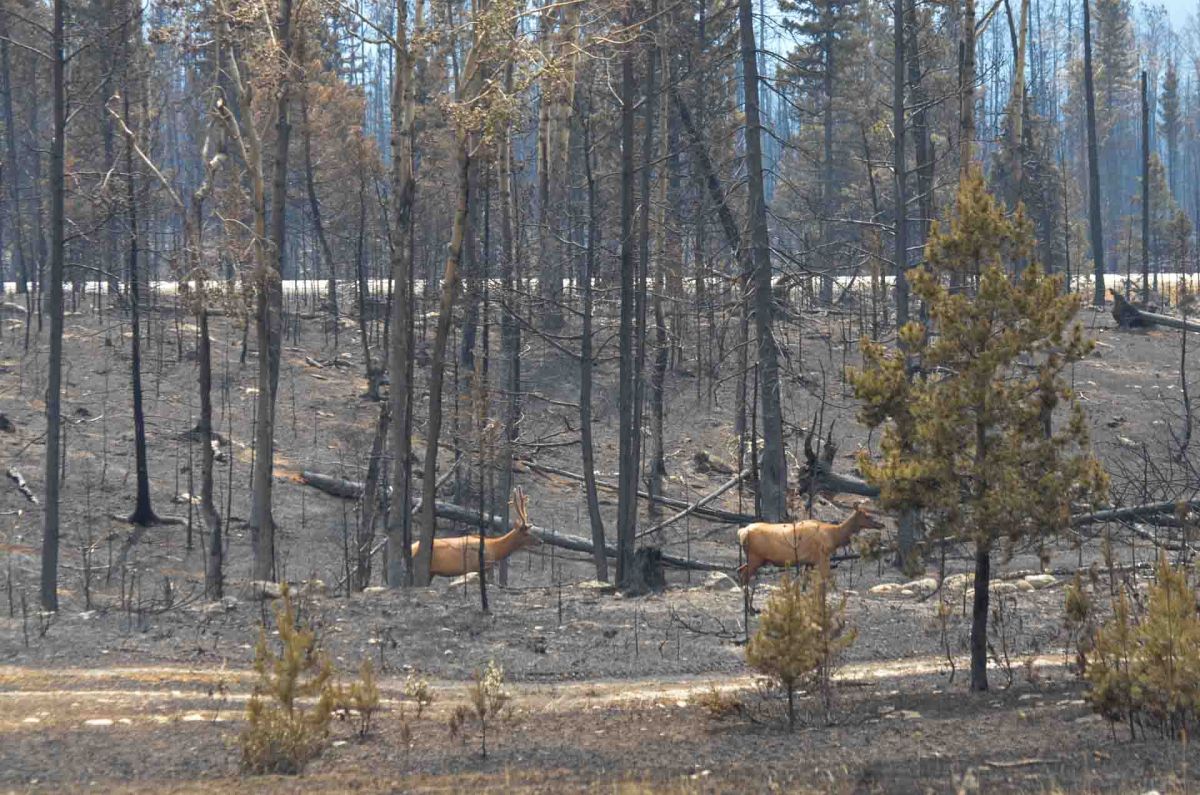As many people in the Jasper National Park townsite face a long road to recovery from a wildfire that burned through the community last week, park officials say wildlife populations in the area will also recover.

On Sunday night, officials released photos of one of the park’s grizzly bears and her two cubs. “Grizzly bear 222” has a GPS collar that allows park officials to track her movements and has helped them determine what she may have done to survive the blaze.
“In the moments leading up to the most extreme wildfire activity on Wednesday, … Grizzly bear 222 and her two cubs tucked themselves into a wet spot by the Athabasca River,” officials said in a series of posts on social media.” According to Parks Canada’s human wildlife specialists, she looks like a very healthy grizzly bear right now.
“She has been eating a mix of berries and clover on the edge of the Jasper Park Lodge golf course.”
A number of wildfires burning in the park triggered an evacuation order last week that saw an estimated 25,000 people flee the area before flames entered the Jasper townsite. Emergency officials believe about 30 per cent of the town has been damaged or destroyed.

But Alan Fehr, the superintendent of Jasper National Park, said Sunday that wildfire-impacted areas of the park’s natural landscape should recover relatively quickly.
“It will be full of vegetation and life and vibrancy in no time at all,” he said.
On their Sunday night social media posts, Parks Canada officials noted that in the face of wildfires, “the extraordinary instincts of wildlife, like bears and elk, guide them to safety.”

Get daily National news
“Fire is a natural process and we expect animals to find new places to live,” said James McCormick, who specializes in looking at the co-existence between humans and wildlife for Parks Canada. “We have a team of 18 people managing wildlife in and around the town of Jasper.
“Because of all the fire and things that have been damaged, we’re looking at trying to manage garbage, food waste and spoiled food. We’re also out trying to look for any animals that were physically impacted by the fire and we have seen some that perished to the fire.”
Officials noted that after a wildfire burns through an area, it is easier to see things in the distance. They said at least one grizzly bear in the park has been seen feeding on an animal carcass and warned bears can become “extra aggressive” when defending their food.
Parks Canada said that the fires burning in the national park this summer will have an impact on wildlife and how animals move through the region and that staff will be working to ensure the animals do not pose an additional threat to area residents when they are allowed to return.
After wildfires tore through the Fort McMurray area in 2016, an expert on wolf biology and former research scientist with the Canadian Wildlife Service spoke to Global News about the aftermath of large fires and the impact on wildlife.
“What happens in big fires is that plant succession would be set back and as a result there would be a rejuvenation of the process of the maturation of plant systems,” said Lu Carbyn, an adjunct professor at the University of Alberta, at the time. “So you’d have stages that are sort of the latter part of plant succession and some that are at the earlier stages of plant succession, and so different wildlife complexes would adjust to those different successional stages.”
Plant succession refers to changes in vegetation in a specific area over a period of time and is dependent on factors like disasters, changing conditions or human activity.
In speaking about the 2016 Fort McMurray fire, Carbyn said that within one to three years, bears are actually likely to benefit from fires as there will be a good chance of massive berry crops like blueberries emerging, allowing bears to return and do quite well.
For the latest information on which areas in Alberta are under an evacuation alert or order due to a wildfire, visit the Alberta Emergency Alert website.
For the latest information on the wildfire status and danger across the province, visit the Alberta Wildfire website.
The latest information on fire advisories, restrictions and bans across the province can be found on the Alberta fire bans website.
For the latest on road closures in Alberta, you can visit the 511 Alberta website.





















Comments